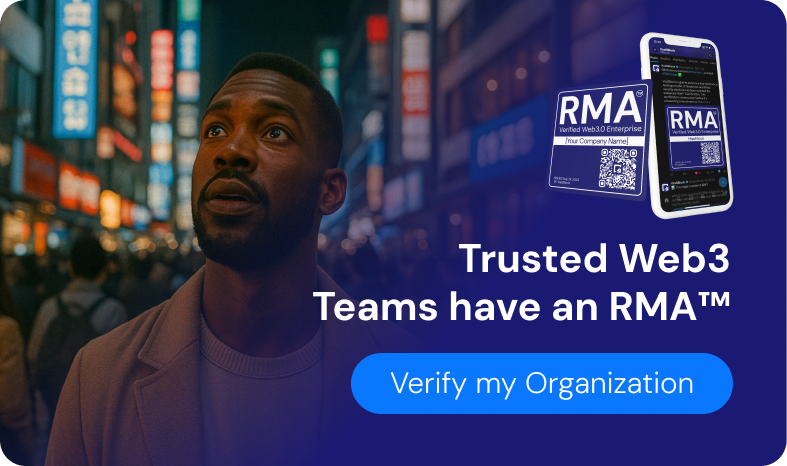
Superrare
Risk Management
?Risk Management
The RMA™ is a blockchain credibility certification assessing governance, transparency, security, and results, providing trusted verification for businesses in Web3.
VaaSBlock has not audited this project and cannot vouch for this organization.
RMA™ Status: ❌ Unverified
Verification of 6 major compliance criteria.
Technology
?Technology
A collection of public facing information, data collected through partners and our own tools view we present a projects technology in one place for easy verification.
Analysis and testing of tech infrastructures.
Marketing
Alpha?Marketing
Top level look at a projects marketing capablities currently in alpha this section will grow to show quickly how a project promotes itself and the effectiveness.
Screening of user base and community feedback.
Background
?Background
Using multiple public facing sources across the web view a summary of a projects purpose, key achievements and general overview.
Collection of basic administrative documentation.
Risk Management
Last Updated
2025/4/16
Transparency
Transparency Score
Algorithmic assessment of a project’s transparency level, using multiple public data points to measure its commitment to compliance, documentation, and clarity in communication.
Transparency Score
Category Rank
A ranking that positions the organization among its industry peers, evaluating its relative performance based on key compliance, credibility, and transparency indicators.
Category Rank
SuperRare vs RWA
VaaSBlock Rank
A global ranking that compares the organization against all entities listed on VaaSBlock, reflecting its overall credibility, transparency, and operational performance versus the full Web3 ecosystem.
VaaSBlock Rank
SuperRare vs All Listed Organizations
Transparency
Transparency Score
Transparency Score
Algorithmic assessment of a project’s transparency level, using multiple public data points to measure its commitment to compliance, documentation, and clarity in communication.
Category Rank
SuperRare vs RWA
Category Rank
A ranking that positions the organization among its industry peers, evaluating its relative performance based on key compliance, credibility, and transparency indicators.
VaaSBlock Rank
SuperRare vs All Listed Organizations
VaaSBlock Rank
A global ranking that compares the organization against all entities listed on VaaSBlock, reflecting its overall credibility, transparency, and operational performance versus the full Web3 ecosystem.
RMA™
✘ UnverifiedCorporate Governance
The verification of fundamental governance, organizational structure, including verifying the entity’s legal registration and adherence to local laws and regulations.
Corporate
Governance

Team Proficency
Evaluation of an organization’s personnel, ensuring that crucial team members possess the expertise and dedication necessary to execute current business models and scale effectively.
Team
Proficiency

Technology & Security
Assessment of the organization’s technological framework, including blockchain integrations (where relevant), system architecture, and overall IT infrastructure.
Technology
& Security

Revenue Model
Comprehensively evaluation of a company’s income-generating strategies (how do they make or intend to make money), ensuring financial robustness and sustainability.
Revenue
Model

Results Delivered
The Results Delivered component of the RMA™ audit comprehensively evaluates an organization’s ability to achieve its goals and honor its commitments.
Results
Delivered

Planning & Transparency
The Planning and Transparency component of the RMA™ audit offers a thorough assessment of how an organization manages its workflow and prepares for unexpected challenges.
Planning &
Transparency

Technology
Marketing
Marketing Effectiveness
This score assesses the impact of detected marketing activity and the corresponding price movement of a token. The score understands whole market movements to ensure tokens are assessed fairly against peers.
Marketing Effectiveness
Confidence Index
This index determines our confidence in the score we have given. Generally, as more data is collected, the confidence index will increase. If a project has lots of activity, this confidence is earned faster.
Confidence Index
VaaSBlock Rank
This identifies where a project sits compared to all projects accessed for Marketing Effectiveness.
VaaSBlock Rank
SuperRare vs All Listed Organizations
Marketing Effectiveness
Marketing Effectiveness
This score assesses the impact of detected marketing activity and the corresponding price movement of a token. The score understands whole market movements to ensure tokens are assessed fairly against peers.
Confidence Index
Confidence Index
This index determines our confidence in the score we have given. Generally, as more data is collected, the confidence index will increase. If a project has lots of activity, this confidence is earned faster.
VaaSBlock Rank
SuperRare vs All Listed Organizations
VaaSBlock Rank
This identifies where a project sits compared to all projects accessed for Marketing Effectiveness.
No Chain No Gain™ Podcast ⛉
This Organization is yet to join the No Chain No Gain™ Podcast and share insights on what makes their business trustable and innovative.
💡 NCNG generated over 1 Million impressions in its first six months of existence.
PR Impact
PR Impact
VaaSBlock provides estimations to the impact that traditional digital media can have on a project. This is an early release; more areas of PR are planned in future versions.
Search Terms ? Search TermsThese are the terms we discovered the article for on page one of Google. | Est. Traffic ? Estimated TrafficWe estimate how much traffic an article will get. Generally, our estimations are slightly higher than those of more established tools. We are working on the algorithm all the time, and results could change. | Est. Value ? Estimated ValueBased on the estimated traffic we generate an estimation for what this traffic would have cost to generate if you tried to target these users with ads. The positions for the article on google and the location of the traffic are the major factors in this estimation. | |||
|---|---|---|---|---|---|
Super Rare Games source: superraregames.com | Super Rare Games… — Super Rare Games source: superraregames.com | Organic | superraregames.com | ||
Superrare source: Opensea | Superrare… — Superrare source: Opensea | Organic | opensea.io | ||
Superrare Rare source: Forbes | Superrare Rare… — Superrare Rare source: Forbes | Organic | forbes.com | ||
399667 78 source: Pitchbook | 399667 78… — 399667 78 source: Pitchbook | Organic | pitchbook.com |
| Est. Traffic | Est. Value | ||
|---|---|---|---|
Super Rare Games… — | |||
Superrare… — | |||
Superrare Rare… — | |||
399667 78… — |
Ratings
AlphaOverall
Aggregated Rating
The combined score with AI-driven weighted analysis to provide the best possible project rating.
8 verifications
Confidence Index
This index determines our confidence in the score we have given. Generally, as more data is collected, the confidence index will increase. If a project has lots of activity, this confidence is earned faster.
None
8 verifications
External Reviews
Third-party reviews are important for your reputation.
You have additional elements to add? Work with us and keep your profile updated.
Background
Organization Name – Superrare
Category –  RWA
RWA
About
powered by irmaAI
irmaAISuperRare emerged in 2018 from a vision to create a premium online marketplace where digital art could be authenticated, owned, and traded as unique, single-edition items. Born out of discussions betw…een John Crain, Charles Crain, and Jonathan Perkins—three digital art enthusiasts who initially worked on Pixura—the platform officially launched in April 2018 after about six months of development in Brooklyn. Their goal was to solve a long-standing problem: digital art was everywhere, but without scarcity or provenance, it lacked value. SuperRare introduced NFTs—non‑fungible tokens minted on Ethereum—as a way to certify both originality and ownership, enabling a global, transparent market for digital artists.
At its core, SuperRare is curated. Unlike open marketplaces flooded with generative or utility-focused tokens, SuperRare focuses solely on high-quality digital art. To list a work, artists historically needed to apply and be vetted by SuperRare Labs, ensuring each piece is unique, original, and meets strict standards. This exclusivity fostered a reputation among collectors akin to a hybrid of Instagram and Christie’s, where emerging and established digital artists could exhibit in a refined, gallery-like online setting. Within its first three years, the application process remained centralized, reinforcing the platform’s commitment to maintaining a consistent, high-caliber collection.
Sales grew rapidly: by mid‑2025, SuperRare had facilitated over US $300 million in on‑chain sales, with artists earning around US $180 million in total—numbers that underscore both robust demand from collectors and strong creator revenue.
Key to its appeal was the royalty model: artists receive 10 % on every secondary sale—an early innovation that has since become a standard across the NFT ecosystem.
In 2021, SuperRare began transitioning toward community governance. They launched the RARE token and evolved the platform into a DAO, enabling token holders to decide on artist onboarding, curator spaces, commission structures, and treasury operations.
This shift allowed for more democratic control while retaining the initial standards of curation. Alongside governance, SuperRare introduced “Spaces”—curated mini‑galleries within the platform where selected curators could showcase and sell artists’ work, earning commissions. These decisions were themselves voted on by RARE token holders.
To support discovery and community engagement, SuperRare launched several initiatives: “Featured” and “Recommended” weekly selections, artist interviews and case studies via SuperRare Insights and Academy, and the Rare Protocol—a decentralized curation system enabling users to stake tokens on artists, participate in “curation pools,” and further influence visibility and discovery.
This blend of art, community, and on‑chain social graphing created a vibrant ecosystem that went beyond simple transactions.
SuperRare emphasized marketplace innovation by enabling primary timed auctions, reserve auctions, “Buy Now” options, and an open offers system. All transactions were secured via Ethereum smart contracts, ensuring that NFTs and bids remained locked until sale resolution.
Despite its sophisticated features, the platform was candid about drawbacks: its 15 % gallery fee, Ethereum-only payments, and gas costs made participation more expensive and less accessible than some competitors
To bolster trust and stability, SuperRare implemented a bug bounty program in 2021, incentivizing security researchers to report issues and thereby reinforcing the platform’s technical integrity.
Over time, SuperRare’s model of curated quality, artist royalties, social engagement, and community governance set a strong foundation in the NFT space—especially as sales reached hundreds of millions and top artworks fetched multi-million-dollar prices. Notable artists like XCOPY and Robbie Barrat secured high-profile placements, with XCOPY alone generating over $50 million in primary sales and peaking at over $7 million for a single piece.
Fundraising also played a key role. SuperRare Labs raised roughly $9 million in a Series A round in March 2021, attracting investments from firms including 1confirmation, Samsung Next, Mark Cuban, Chamath Palihapitiya, and others.
This financial backing fueled development of marketplace features, the DAO infrastructure, and community initiatives. The headquarters shifted over time—from initial operations in Brooklyn to formal registration in Wilmington, Delaware per PitchBook , and subsequently a presence in San Diego, California per LinkedIn
LinkedIn
—highlighting its U.S. corporate footprint.
Today, SuperRare remains a leading destination for fine digital art, balancing exclusivity with innovation. Curators and collectors continue to build reputations through Spaces and staking, while artists benefit from royalties and global exposure. Even as tools, marketplaces, and regulatory environments evolve, SuperRare’s impact on digital art culture and on‑chain authentication is clear: it pioneered artist-first economics and set a bar for quality and community in NFT marketplaces. With millions transacted, hundreds of artists showcased, and evolving governance, SuperRare stands as a definitive example of how art and blockchain technology can intersect meaningfully. Read More
Creation Date
December 2025
Headquarters
San Diego, California
Organization Maturity Level
Growing Business
RMA™ Type
–
Useful Links
Website – superrare.com
Notable Achievements
2018
Platform launched
2021
RARE token/DAO
2021
Introduction of Spaces
2021
$9 M Series A
2025
$300 M sales
- vaasblock.com /
- RWA /
- Superrare



















